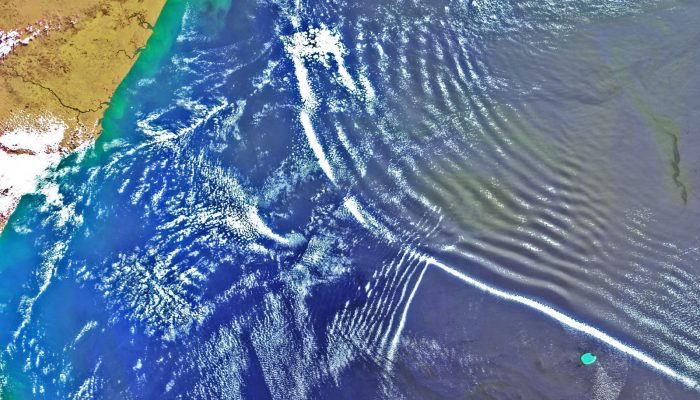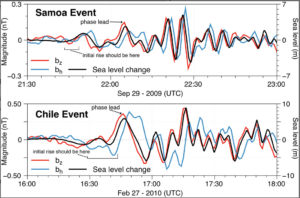
It’s been well established that tsunamis generate magnetic fields as they move seawater (which is conductive unlike freshwater) through the Earth’s magnetic field. Although researchers previously predicted that the tsunami’s magnetic field would arrive before a change in sea level, they lacked the means to simultaneously measure magnetics and sea level to confirm this phenomenon.
Now, a new study finds the magnetic field generated by a tsunami can be detected a few minutes earlier than changes in sea level, which could improve warnings of these giant waves. The study provides real-world evidence for using tsunamis’ magnetic fields to predict the height of tsunami waves using data from two real events — a 2009 tsunami in Samoa and a 2010 tsunami in Chile — that have both sets of necessary data. The study was recently published in the American Geophysical Union’s (AGU) Journal of Geophysical Research: Solid Earth, which focuses on the physics and chemistry of the solid Earth.
“It is very exciting because in previous studies we didn’t have the observation [of] sea level change,” said Zhiheng Lin, senior study author and a geophysicist at Kyoto University. “We have observations [of] sea level change, and we find that the observation agrees with our magnetic data as well as theoretical simulation.”
Four key findings:
- The magnetic field generated by a tsunami arrives ahead of sea-level change and its magnitude can be used to estimate the tsunami’s wave height
- How much earlier the magnetic field arrives depends on the water depth
- Authors found the early arrival time to be about one minute prior to sea level change when the water depth was a 4800-meter-deep sea
- If incorporated into tsunami risk models, this could provide earlier disaster warning, potentially saving lives
How the team arrived at their findings
The research team looked at simultaneous measurements of sea level change from seafloor pressure data and magnetic fields during the two tsunamis. They found that the primary arrival of the magnetic field, like that of the beginning of a seismic wave, can be used for the purpose of early tsunami warning. The tsunami-generated magnetic field is so sensitive that even a wave height of a few centimeters can be detected.
Comparing the horizontal and vertical components of the tsunami magnetic field with sea level change, researchers found that both components can precisely predict tsunami sea level change, if models include good estimates for ocean depth and the electrical structure below the seafloor.

Comparison of the simultaneous observed magnetic field with sea level change. The comparison shows the peaks of tsunami bz arrive slightly earlier than the sea level changes.
What does this new discovery mean?
The authors explain that this relationship between magnetic fields and wave height can be used to improve tsunami source models, which estimate the initial sea surface topography of a tsunami and then predict the wave arrival time and height. It serves as important data for informing disaster readiness and response.
Unfortunately, the difficulty of maintaining already limited observational stations means that these types of data from tsunamis are often not available. Additionally, these findings only apply to tsunamis that are detected in deep-sea settings and not in coastal environments. This is most likely because the inherent magnetic field noise that develops in shallow coastal water affects the data collected in coastal water.
Although more research on the subject is certainly welcome, the authors conclude that predicting the scale of these severe events — which have the potential to cause immense damage to large areas — makes the available predictions worthwhile.





Michael Davias
Great application of curiosity! The concept of a tsunami in my mind was a single great big wave, but the empirical evidence is showing that a series of outgoing ripples occur. First small and slowly growing bigger as time passes. The concept is likely to be applicable for any catastrophic event that disturbs the planet. Should such waves be expected from the debris outflow from cosmic impact events?